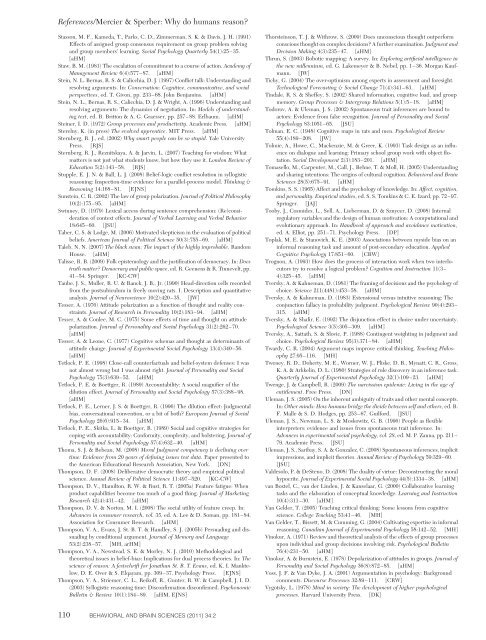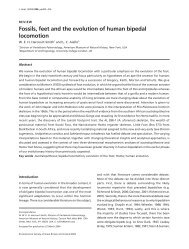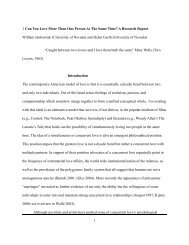Why do humans reason? Arguments for an argumentative theory
Why do humans reason? Arguments for an argumentative theory
Why do humans reason? Arguments for an argumentative theory
You also want an ePaper? Increase the reach of your titles
YUMPU automatically turns print PDFs into web optimized ePapers that Google loves.
References/Mercier & Sperber: <strong>Why</strong> <strong>do</strong> <strong>hum<strong>an</strong>s</strong> <strong>reason</strong>?Stasson, M. F., Kameda, T., Parks, C. D., Zimmerm<strong>an</strong>, S. K. & Davis, J. H. (1991)Effects of assigned group consensus requirement on group problem solving<strong>an</strong>d group members’ learning. Social Psychology Quarterly 54(1):25–35.[aHM]Staw, B. M. (1981) The escalation of commitment to a course of action. Academy ofM<strong>an</strong>agement Review 6(4):577–87. [aHM]Stein, N. L. Bernas, R. S. & Calicchia, D. J. (1997) Conflict talk: Underst<strong>an</strong>ding <strong>an</strong>dresolving arguments. In: Conversation: Cognitive, communicative, <strong>an</strong>d socialperspectives, ed. T. Givon, pp. 233–68. John Benjamins. [aHM]Stein, N. L., Bernas, R. S., Calicchia, D. J. & Wright, A. (1996) Underst<strong>an</strong>ding <strong>an</strong>dresolving arguments: The dynamics of negotiation. In: Models of underst<strong>an</strong>dingtext, ed. B. Britton & A. G. Graesser, pp. 257–88. Erlbaum. [aHM]Steiner, I. D. (1972) Group processes <strong>an</strong>d productivity. Academic Press. [aHM]Sterelny, K. (in press) The evolved apprentice. MIT Press. [aHM]Sternberg, R. J., ed. (2002) <strong>Why</strong> smart people c<strong>an</strong> be so stupid. Yale UniversityPress. [RJS]Sternberg, R. J., Reznitskaya, A. & Jarvin, L. (2007) Teaching <strong>for</strong> wis<strong>do</strong>m: Whatmatters is not just what students know, but how they use it. Lon<strong>do</strong>n Review ofEducation 5(2):143–58. [RJS]Stupple, E. J. N. & Ball, L. J. (2008) Belief-logic conflict resolution in syllogistic<strong>reason</strong>ing: Inspection-time evidence <strong>for</strong> a parallel-process model. Thinking &Reasoning 14:168–81. [EJNS]Sunstein, C. R. (2002) The law of group polarization. Journal of Political Philosophy10(2):175–95. [aHM]Swinney, D. (1979) Lexical access during sentence comprehension: (Re)considerationof context effects. Journal of Verbal Learning <strong>an</strong>d Verbal Behavior18:645–60. [JSU]Taber, C. S. & Lodge, M. (2006) Motivated skepticism in the evaluation of politicalbeliefs. Americ<strong>an</strong> Journal of Political Science 50(3):755–69. [aHM]Taleb, N. N. (2007) The black sw<strong>an</strong>: The impact of the highly improbable. R<strong>an</strong><strong>do</strong>mHouse. [aHM]Talisse, R. B. (2009) Folk epistemology <strong>an</strong>d the justification of democracy. In: Doestruth matter? Democracy <strong>an</strong>d public space, ed. R. Geenens & R. Tinnevelt, pp.41–54. Springer. [KC-CW]Taube, J. S., Muller, R. U. & R<strong>an</strong>ck, J. B., Jr. (1990) Head-direction cells recordedfrom the postsubiculum in freely moving rats. I. Description <strong>an</strong>d qu<strong>an</strong>titative<strong>an</strong>alysis. Journal of Neuroscience 10(2):420–35. [JW]Tesser, A. (1976) Attitude polarization as a function of thought <strong>an</strong>d reality constraints.Journal of Research in Personality 10(2):183–94. [aHM]Tesser, A. & Conlee, M. C. (1975) Some effects of time <strong>an</strong>d thought on attitudepolarization. Journal of Personality <strong>an</strong>d Social Psychology 31(2):262–70.[aHM]Tesser, A. & Leone, C. (1977) Cognitive schemas <strong>an</strong>d thought as determin<strong>an</strong>ts ofattitude ch<strong>an</strong>ge. Journal of Experimental Social Psychology 13(4):340–56.[aHM]Tetlock, P. E. (1998) Close-call counterfactuals <strong>an</strong>d belief-system defenses: I wasnot almost wrong but I was almost right. Journal of Personality <strong>an</strong>d SocialPsychology 75(3):639–52. [aHM]Tetlock, P. E. & Boettger, R. (1989) Accountability: A social magnifier of thedilution effect. Journal of Personality <strong>an</strong>d Social Psychology 57(3):388–98.[aHM]Tetlock, P. E., Lerner, J. S. & Boettger, R. (1996) The dilution effect: Judgmentalbias, conversational convention, or a bit of both? Europe<strong>an</strong> Journal of SocialPsychology 26(6):915–34. [aHM]Tetlock, P. E., Skitka, L. & Boettger, R. (1989) Social <strong>an</strong>d cognitive strategies <strong>for</strong>coping with accountability: Con<strong>for</strong>mity, complexity, <strong>an</strong>d bolstering. Journal ofPersonality <strong>an</strong>d Social Psychology 57(4):632–40. [aHM]Thoma, S. J. & Bebeau, M. (2008) Moral Judgment competency is declining overtime: Evidence from 20 years of defining issues test data. Paper presented tothe Americ<strong>an</strong> Educational Research Association, New York. [DN]Thompson, D. F. (2008) Deliberative democratic <strong>theory</strong> <strong>an</strong>d empirical politicalscience. Annual Review of Political Science 11:497–520. [KC-CW]Thompson, D. V., Hamilton, R. W. & Rust, R. T. (2005a) Feature fatigue: Whenproduct capabilities become too much of a good thing. Journal of MarketingResearch 42(4):431–42. [aHM]Thompson, D. V. & Norton, M. I. (2008) The social utility of feature creep. In:Adv<strong>an</strong>ces in consumer research, vol. 35, ed. A. Lee & D. Som<strong>an</strong>, pp. 181–84.Association <strong>for</strong> Consumer Research. [aHM]Thompson, V. A., Ev<strong>an</strong>s, J. St. B. T. & H<strong>an</strong>dley, S. J. (2005b) Persuading <strong>an</strong>d dissuadingby conditional argument. Journal of Memory <strong>an</strong>d L<strong>an</strong>guage53(2):238–57. [MH, arHM]Thompson, V. A., Newstead, S. E. & Morley, N. J. (2010) Metho<strong>do</strong>logical <strong>an</strong>dtheoretical issues in belief-bias: Implications <strong>for</strong> dual process theories. In: Thescience of <strong>reason</strong>: A festschrift <strong>for</strong> Jonath<strong>an</strong> St. B. T. Ev<strong>an</strong>s, ed. K. I. M<strong>an</strong>ktelow,D. E. Over & S. Elqayam, pp. 309–37. Psychology Press. [EJNS]Thompson, V. A., Striemer, C. L., Reikoff, R., Gunter, R. W. & Campbell, J. I. D.(2003) Syllogistic <strong>reason</strong>ing time: Disconfirmation disconfirmed. PsychonomicBulletin & Review 10(1):184–89. [aHM, EJNS]Thorsteinson, T. J. & Withrow, S. (2009) Does unconscious thought outper<strong>for</strong>mconscious thought on complex decisions? A further examination. Judgment <strong>an</strong>dDecision Making 4(3):235–47. [aHM]Thrun, S. (2003) Robotic mapping: A survey. In: Exploring artificial intelligence inthe new millennium, ed. G. Lakemeyer & B. Nebel, pp. 1–36. Morg<strong>an</strong> Kaufm<strong>an</strong>n.[JW]Tichy, G. (2004) The over-optimism among experts in assessment <strong>an</strong>d <strong>for</strong>esight.Technological Forecasting & Social Ch<strong>an</strong>ge 71(4):341–63. [aHM]Tindale, R. S. & Sheffey, S. (2002) Shared in<strong>for</strong>mation, cognitive load, <strong>an</strong>d groupmemory. Group Processes & Intergroup Relations 5(1):5–18. [aHM]To<strong>do</strong>rov, A. & Ulem<strong>an</strong>, J. S. (2002) Spont<strong>an</strong>eous trait inferences are bound toactors: Evidence from false recognition. Journal of Personality <strong>an</strong>d SocialPsychology 83:1051–65. [JSU]Tolm<strong>an</strong>, E. C. (1948) Cognitive maps in rats <strong>an</strong>d men. Psychological Review55(4):189–208. [JW]Tolmie, A., Howe, C., Mackenzie, M. & Greer, K. (1993) Task design as <strong>an</strong> influenceon dialogue <strong>an</strong>d learning: Primary school group work with object flotation.Social Development 2(3):183–201. [aHM]Tomasello, M., Carpenter, M., Call, J., Behne, T. & Moll, H. (2005) Underst<strong>an</strong>ding<strong>an</strong>d sharing intentions: The origins of cultural cognition. Behavioral <strong>an</strong>d BrainSciences 28(5):675–91. [aHM]Tomkins, S. S. (1965) Affect <strong>an</strong>d the psychology of knowledge. In: Affect, cognition,<strong>an</strong>d personality: Empirical studies, ed. S. S. Tomkins & C. E. Izard, pp. 72–97.Springer. [JAJ]Tooby, J., Cosmides, L., Sell, A., Lieberm<strong>an</strong>, D. & Sznycer, D. (2008) Internalregulatory variables <strong>an</strong>d the design of hum<strong>an</strong> motivation: A computational <strong>an</strong>devolutionary approach. In: H<strong>an</strong>dbook of approach <strong>an</strong>d avoid<strong>an</strong>ce motivation,ed. A. Elliot, pp. 251–71. Psychology Press. [DP]Toplak, M. E. & St<strong>an</strong>ovich, K. E. (2003) Associations between myside bias on <strong>an</strong>in<strong>for</strong>mal <strong>reason</strong>ing task <strong>an</strong>d amount of post-secondary education. AppliedCognitive Psychology 17:851–60. [CRW]Trognon, A. (1993) How <strong>do</strong>es the process of interaction work when two interlocutorstry to resolve a logical problem? Cognition <strong>an</strong>d Instruction 11(3–4):325–45. [aHM]Tversky, A. & Kahnem<strong>an</strong>, D. (1981) The framing of decisions <strong>an</strong>d the psychology ofchoice. Science 211(4481):453–58. [aHM]Tversky, A. & Kahnem<strong>an</strong>, D. (1983) Extensional versus intuitive <strong>reason</strong>ing: Theconjunction fallacy in probability judgment. Psychological Review 90(4):293–315. [aHM]Tversky, A. & Shafir, E. (1992) The disjunction effect in choice under uncertainty.Psychological Science 3(5):305–309. [aHM]Tversky, A., Sattath, S. & Slovic, P. (1988) Contingent weighting in judgment <strong>an</strong>dchoice. Psychological Review 95(3):371–84. [aHM]Twardy, C. R. (2004) Argument maps improve critical thinking. Teaching Philosophy27:95–116. [MH]Tweney, R. D., Doherty, M. E., Worner, W. J., Pliske, D. B., Mynatt, C. R., Gross,K. A. & Arkkelin, D. L. (1980) Strategies of rule discovery in <strong>an</strong> inference task.Quarterly Journal of Experimental Psychology 32(1):109–23. [aHM]Twenge, J. & Campbell, R. (2009) The narcissism epidemic: Living in the age ofentitlement. Free Press. [DN]Ulem<strong>an</strong>, J. S. (2005) On the inherent ambiguity of traits <strong>an</strong>d other mental concepts.In: Other minds: How <strong>hum<strong>an</strong>s</strong> bridge the divide between self <strong>an</strong>d others, ed. B.F. Malle & S. D. Hodges, pp. 253–67. Guil<strong>for</strong>d. [JSU]Ulem<strong>an</strong>, J. S., Newm<strong>an</strong>, L. S. & Moskowitz, G. B. (1996) People as flexibleinterpreters: evidence <strong>an</strong>d issues from spont<strong>an</strong>eous trait inference. In:Adv<strong>an</strong>ces in experimental social psychology, vol. 28, ed. M. P. Z<strong>an</strong>na, pp. 211–79. Academic Press. [JSU]Ulem<strong>an</strong>, J. S., Saribay, S. A. & Gonzalez, C. (2008) Spont<strong>an</strong>eous inferences, implicitimpressions, <strong>an</strong>d implicit theories. Annual Review of Psychology 59:329–60.[JSU]Valdesolo, P. & DeSteno, D. (2008) The duality of virtue: Deconstructing the moralhypocrite. Journal of Experimental Social Psychology 44(5):1334–38. [aHM]v<strong>an</strong> Boxtel, C., v<strong>an</strong> der Linden, J. & K<strong>an</strong>selaar, G. (2000) Collaborative learningtasks <strong>an</strong>d the elaboration of conceptual knowledge. Learning <strong>an</strong>d Instruction10(4):311–30. [aHM]V<strong>an</strong> Gelder, T. (2005) Teaching critical thinking: Some lessons from cognitivescience. College Teaching 53:41–46. [MH]V<strong>an</strong> Gelder, T., Bissett, M. & Cumming, G. (2004) Cultivating expertise in in<strong>for</strong>mal<strong>reason</strong>ing. C<strong>an</strong>adi<strong>an</strong> Journal of Experimental Psychology 58:142–52. [MH]Vinokur, A. (1971) Review <strong>an</strong>d theoretical <strong>an</strong>alysis of the effects of group processesupon individual <strong>an</strong>d group decisions involving risk. Psychological Bulletin76(4):231–50. [aHM]Vinokur, A. & Burnstein, E. (1978) Depolarization of attitudes in groups. Journal ofPersonality <strong>an</strong>d Social Psychology 36(8):872–85. [aHM]Voss, J. F. & V<strong>an</strong> Dyke, J. A. (2001) Argumentation in psychology: Backgroundcomments. Discourse Processes 32:89–111. [CRW]Vygotsky, L. (1978) Mind in society: The development of higher psychologicalprocesses. Harvard University Press. [DK]110 BEHAVIORAL AND BRAIN SCIENCES (2011) 34:2




